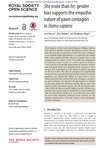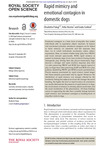Search
Now showing items 1-10 of 10
Untitled
(2015)
Recent developments in the study of animal cognition and emotion have resulted in the ‘judgement bias’ model of animal welfare. Judgement biases describe the way in which changes in affective state are characterized by ...
Emotion recognition deficits in eating disorders are explained by co-occurring alexithymia
(The Royal Society, 2015)
Previous research has yielded inconsistent findings regarding the ability of individuals with eating disorders (EDs) to recognize facial emotion, making the clinical features of this population hard to determine. This study ...
Balance and coordination after viewing stereoscopic 3D television
(The Royal Society, 2015)
Manufacturers and the media have raised the possibility that viewing stereoscopic 3D television (S3D TV) may cause temporary disruption to balance and visuomotor coordination. We looked for evidence of such effects in a ...
She more than he: gender bias supports the empathic nature of yawn contagion in Homo sapiens
(2016)
Psychological clinical and neurobiological findings endorse that empathic abilities are more developed in women than in men. Because there is growing evidence that yawn contagion is an empathy-based phenomenon, we expect ...
Ravens New Caledonian crows and jackdaws parallel great apes inmotor self-regulation despite smaller brains
(2016)
Overriding motor impulses instigated by salient perceptual stimuli represent a fundamental inhibitory skill. Such motor self-regulation facilitates more rational behaviour, as it brings economy into the bodily interaction ...
The need for speed
(2016)
How do animals follow demarcated paths? Different species are sensitive to optic flow and one control solution is to maintain the balance of flow symmetry across visual fields however, it is unclear whether animals are ...
Rapid mimicry and emotional contagion in domestic dogs
(2015)
Emotional contagion is a basic form of empathy that makes individuals able to experience others’ emotions. In human and non-human primates, emotional contagion can be linked to facial mimicry, an automatic and fast response ...
Assessing recognition memory using confidence ratings and response times
(2016)
Classification of stimuli into categories (such as ‘old’ and ‘new’ in tests of recognition memory or ‘present’ versus ‘absent’ in signal detection tasks) requires the mapping of internal signals to discrete responses. ...
Language influences music harmony perception
(2016)
Many studies have revealed shared music–language processing resources by finding an influence of music harmony manipulations on concurrent language processing. However, the nature of the shared resources has remained ...
How far will a behaviourally flexible invasive bird go to innovate?
(2016)
Behavioural flexibility is considered a key factor in the ability to adapt to changing environments. A traditional way of characterizing behavioural flexibility is to determine whether individuals invent solutions to novel ...










